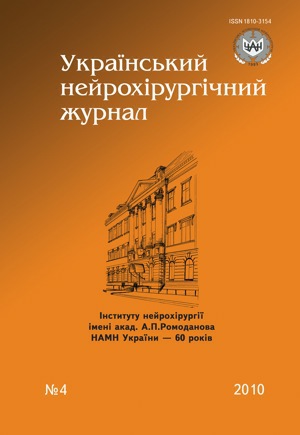Pathogenic connection of Chiari anomaly and syringomyelia
DOI:
https://doi.org/10.25305/unj.90147Keywords:
anomaly of Chiari, syringomyelia, posterior cranial fossaAbstract
The aim of this research — studying of correlation between posterior cranial fossa size and degree of cerebellar tonsils displacement, size of cyrix cysts, and speed of disease progression.
The research is based on diagnostic data analysis before and after surgery at 120 patients with Chiari malformation, liquor circulation disorders on craniovertebral level, with or without syringomyelia.
Received data suggest that the smaller size of the posterior cranial fossa is, the degree of cerebellar tonsils dislocation is greater, cyrix cysts are larger and disease duration is less before surgical treatment performing.
References
Chauvet D. Dura splitting decompression in Chiari type 1 malformation: clinical experience and radiological findings / D. Chauvet, A. Carpentier, B. George // Neurosurg. Rev. — 2009. — V.32, N4. — P.465–470.
Syringoperitoneal shunt in the treatment of syringomyelia / P. Kunert, M. Janowski, A. Zakrzewska [et al.] // Neurol. Neurochir. Pol. — 2009. — V.43, N3. — P.258–262.
Sindou M. Decompression for Chiari type I-malformation (with or without syringomyelia) by extreme lateral foramen magnum opening and expansile duraplasty with arachnoid preservation: comparison with other technical modalities (Literature review) / M. Sindou, E. Gimbert // Adv. Tech. Stand. Neurosurg. — 2009. — V.34. — P.85–110.
Snyder P. Chiari malformation and syringomyelia / P. Snyder // Radiol. Technol. — 2008. — V.79, N6. — P.555–558.
Malformations of the craniocervical junction (Chiari type I and syringomyelia: classification, diagnosis and treatment) / A.A. Fernndez, A.I. Guerrero, M. Martnez [et al.] // BMC Musculoskelet. Disord. — 2009. — V.17, N10. — Suppl.1. — S1.
Chiari type I malformation in a pediatric population / L.A. Aitken, C.E. Lindan, S. Sidney [et al.] // Pediatr. Neurol. — 2009. — V.40, N6. — P.449–454.
Brodbelt A.R. Syringomyelia and Chiari malformations. Quiz / A.R. Brodbelt // Br. J. Neurosurg. — 2009. — V.23, N1. — P.104–105.
Syringomyelia associated with Chiari I malformation / M. Lucchetta, A. Cagnin, M. Calderone [et al.] // Neurol Sci. — 2009. — V.30, N6. — P.525–526.
Incidence of basioccipital hypoplasia in Chiari malformation type I: comparative morphometric study of the posterior cranial fossa. Clinical article / R. Noudel, N. Jovenin, C. Eap [et al.] // J. Neurosurg. — 2009. — V.111, N5. — P.1046–1052.
Suboccipital craniotomy in the surgical treatment of Chiari I malformation / Y.C. Chou, R. Sarkar, F.C. Osuagwu [et al.] // Childs Nerv. Syst. — 2009. — V.25, N9. — P.1111–1114.
Struck A.F. Idiopathic syringomyelia: phase-contrast MR of cerebrospinal fluid flow dynamics at level of foramen magnum / A.F. Struck, V.M. Haughton // Radiology. — 2009. — V.253, N1. — P.184–190.
Sgouros S. Posterior fossa volume in children with Chiari malformation type I. / S. Sgouros, M. Kountouri, K. Natarajan // J. Neurosurg. — 2006. — V.105, N2 (suppl). — P.101–106.
Long-term follow-up of Chiari-related syringomyelia in adults: analysis of 157 surgically treated cases / N. Aghakhani, F. Parker, P. David [et al.] // Neurosurgery. — 2009. — V.64, N2. — P.308–315.
Morphometric analysis of the craniocervical juncture in children with Chiari I malformation and concomitant syringobulbia / R.S. Tubbs, M. Bailey, W.C. Barrow [et al.] // Childs Nerv. Syst. — 2009. — V.25, N6. — P.689–692.
Effects of posterior fossa decompression with and without duraplasty on Chiari malformation-associated hydromyelia / I. Munshi, D. Frim, R. Stine-Reyes [et al.] // Neurosurgery. — 2000. — V.46, N6. — P.1384–1389.
Association of HTLV-I with Arnold Chiari syndrome and syringomyelia / G.M. Viana, J.A. Diniz Neto, S. Furtado Ide [et al.] // Braz. J. Inf. Dis. — 2008. — V.12, N6. — P.536–537.
Downloads
Published
How to Cite
Issue
Section
License
Copyright (c) 2010 E. I. Slynko, Mohamed Kamel M.M. Ragabi

This work is licensed under a Creative Commons Attribution 4.0 International License.
Ukrainian Neurosurgical Journal abides by the CREATIVE COMMONS copyright rights and permissions for open access journals.
Authors, who are published in this Journal, agree to the following conditions:
1. The authors reserve the right to authorship of the work and pass the first publication right of this work to the Journal under the terms of Creative Commons Attribution License, which allows others to freely distribute the published research with the obligatory reference to the authors of the original work and the first publication of the work in this Journal.
2. The authors have the right to conclude separate supplement agreements that relate to non-exclusive work distribution in the form of which it has been published by the Journal (for example, to upload the work to the online storage of the Journal or publish it as part of a monograph), provided that the reference to the first publication of the work in this Journal is included.









